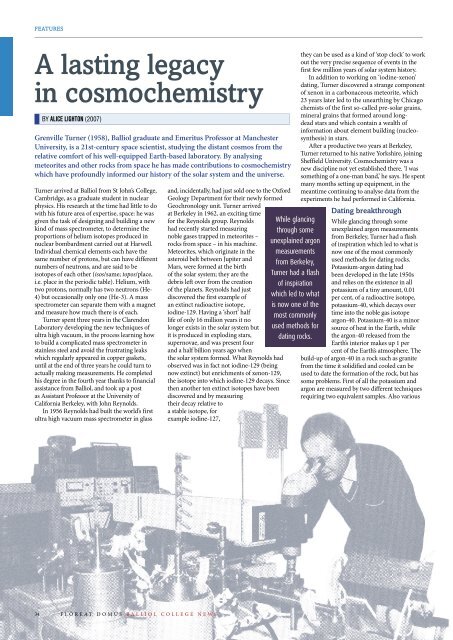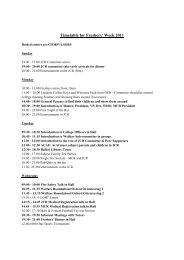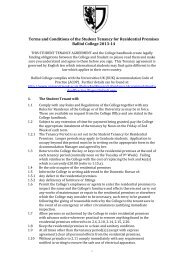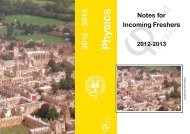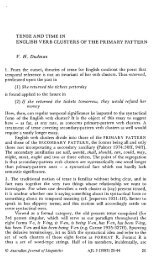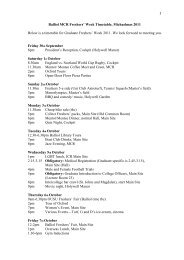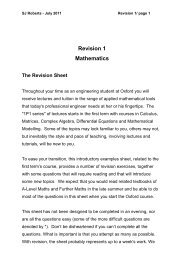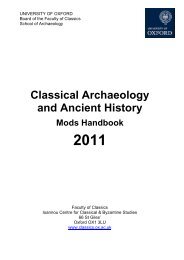Issue 19, 2013 - Balliol College - University of Oxford
Issue 19, 2013 - Balliol College - University of Oxford
Issue 19, 2013 - Balliol College - University of Oxford
You also want an ePaper? Increase the reach of your titles
YUMPU automatically turns print PDFs into web optimized ePapers that Google loves.
features<br />
A lasting legacy<br />
in cosmochemistry<br />
By Alice Lighton (2007)<br />
Grenville Turner (<strong>19</strong>58), <strong>Balliol</strong> graduate and Emeritus Pr<strong>of</strong>essor at Manchester<br />
<strong>University</strong>, is a 21st-century space scientist, studying the distant cosmos from the<br />
relative comfort <strong>of</strong> his well-equipped Earth-based laboratory. By analysing<br />
meteorites and other rocks from space he has made contributions to cosmochemistry<br />
which have pr<strong>of</strong>oundly informed our history <strong>of</strong> the solar system and the universe.<br />
Turner arrived at <strong>Balliol</strong> from St John’s <strong>College</strong>,<br />
Cambridge, as a graduate student in nuclear<br />
physics. His research at the time had little to do<br />
with his future area <strong>of</strong> expertise, space: he was<br />
given the task <strong>of</strong> designing and building a new<br />
kind <strong>of</strong> mass spectrometer, to determine the<br />
proportions <strong>of</strong> helium isotopes produced in<br />
nuclear bombardment carried out at Harwell.<br />
Individual chemical elements each have the<br />
same number <strong>of</strong> protons, but can have different<br />
numbers <strong>of</strong> neutrons, and are said to be<br />
isotopes <strong>of</strong> each other (isos/same; topos/place,<br />
i.e. place in the periodic table). Helium, with<br />
two protons, normally has two neutrons (He-<br />
4) but occasionally only one (He-3). A mass<br />
spectrometer can separate them with a magnet<br />
and measure how much there is <strong>of</strong> each.<br />
Turner spent three years in the Clarendon<br />
Laboratory developing the new techniques <strong>of</strong><br />
ultra high vacuum, in the process learning how<br />
to build a complicated mass spectrometer in<br />
stainless steel and avoid the frustrating leaks<br />
which regularly appeared in copper gaskets,<br />
until at the end <strong>of</strong> three years he could turn to<br />
actually making measurements. He completed<br />
his degree in the fourth year thanks to financial<br />
assistance from <strong>Balliol</strong>, and took up a post<br />
as Assistant Pr<strong>of</strong>essor at the <strong>University</strong> <strong>of</strong><br />
California Berkeley, with John Reynolds.<br />
In <strong>19</strong>56 Reynolds had built the world’s first<br />
ultra high vacuum mass spectrometer in glass<br />
and, incidentally, had just sold one to the <strong>Oxford</strong><br />
Geology Department for their newly formed<br />
Geochronology unit. Turner arrived<br />
at Berkeley in <strong>19</strong>62, an exciting time<br />
for the Reynolds group. Reynolds<br />
had recently started measuring<br />
noble gases trapped in meteorites –<br />
rocks from space – in his machine.<br />
Meteorites, which originate in the<br />
asteroid belt between Jupiter and<br />
Mars, were formed at the birth<br />
<strong>of</strong> the solar system; they are the<br />
debris left over from the creation<br />
<strong>of</strong> the planets. Reynolds had just<br />
discovered the first example <strong>of</strong><br />
an extinct radioactive isotope,<br />
iodine-129. Having a ‘short’ half<br />
life <strong>of</strong> only 16 million years it no<br />
longer exists in the solar system but<br />
it is produced in exploding stars,<br />
supernovae, and was present four<br />
and a half billion years ago when<br />
the solar system formed. What Reynolds had<br />
observed was in fact not iodine-129 (being<br />
now extinct) but enrichments <strong>of</strong> xenon-129,<br />
the isotope into which iodine-129 decays. Since<br />
then another ten extinct isotopes have been<br />
discovered and by measuring<br />
their decay relative to<br />
a stable isotope, for<br />
example iodine-127,<br />
While glancing<br />
through some<br />
unexplained argon<br />
measurements<br />
from Berkeley,<br />
Turner had a flash<br />
<strong>of</strong> inspiration<br />
which led to what<br />
is now one <strong>of</strong> the<br />
most commonly<br />
used methods for<br />
dating rocks.<br />
they can be used as a kind <strong>of</strong> ‘stop clock’ to work<br />
out the very precise sequence <strong>of</strong> events in the<br />
first few million years <strong>of</strong> solar system history.<br />
In addition to working on ‘iodine-xenon’<br />
dating, Turner discovered a strange component<br />
<strong>of</strong> xenon in a carbonaceous meteorite, which<br />
23 years later led to the unearthing by Chicago<br />
chemists <strong>of</strong> the first so-called pre-solar grains,<br />
mineral grains that formed around longdead<br />
stars and which contain a wealth <strong>of</strong><br />
information about element building (nucleosynthesis)<br />
in stars.<br />
After a productive two years at Berkeley,<br />
Turner returned to his native Yorkshire, joining<br />
Sheffield <strong>University</strong>. Cosmochemistry was a<br />
new discipline not yet established there. ‘I was<br />
something <strong>of</strong> a one-man band,’ he says. He spent<br />
many months setting up equipment, in the<br />
meantime continuing to analyse data from the<br />
experiments he had performed in California.<br />
Dating breakthrough<br />
While glancing through some<br />
unexplained argon measurements<br />
from Berkeley, Turner had a flash<br />
<strong>of</strong> inspiration which led to what is<br />
now one <strong>of</strong> the most commonly<br />
used methods for dating rocks.<br />
Potassium-argon dating had<br />
been developed in the late <strong>19</strong>50s<br />
and relies on the existence in all<br />
potassium <strong>of</strong> a tiny amount, 0.01<br />
per cent, <strong>of</strong> a radioactive isotope,<br />
potassium-40, which decays over<br />
time into the noble gas isotope<br />
argon-40. Potassium-40 is a minor<br />
source <strong>of</strong> heat in the Earth, while<br />
the argon-40 released from the<br />
Earth’s interior makes up 1 per<br />
cent <strong>of</strong> the Earth’s atmosphere. The<br />
build-up <strong>of</strong> argon-40 in a rock such as granite<br />
from the time it solidified and cooled can be<br />
used to date the formation <strong>of</strong> the rock, but has<br />
some problems. First <strong>of</strong> all the potassium and<br />
argon are measured by two different techniques<br />
requiring two equivalent samples. Also various<br />
34<br />
floreat domus balliol college news


